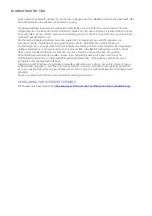
Instructions for Use
USE & LIMITATION OF USE
Observe the user instructions of the rope for correct treatment and proper choice of anchors and
attachment points.
The rope is delivered by
L’ÉQUIPEUR SARL with the spliced eye termination spLIFE.
This innovative eye termination offers particular advantages:
–
The rope remains flexible even near the eye termination.
–
The eye termination spLIFE is low profile and hardly exceeds the rope diameter.
The eye termination spLIFE meets the requirements of EN 1891:1998 for rope type A, i.e. it withstands
15 kN for 3 minutes when new.
The breaking strength quoted is for rope, or rope including the eye termination loaded in a longitudinal
direction. Therefore, never apply a transverse load to a rope end termination eye (e.g. by applying a
load across the eye via two connectors in the same termination eye). Be aware of the loads applied to
the rope in the chosen configuration and never overload it. We recommend safety factors of 7 or more.
The end termination eye spLIFE is low profile and hardly exceeds the rope diameter. Caution! The end
termination eye spLIFE is not suitable for use as a stopper!
Never use this product if, as a result of your physical and/or mental condition, your safety in normal (or
emergency) scenarios might be compromised. Modifications or additions to the eye termination not
acceptable, unless done by the manufacturer.
Protect the rope and particularly the eye termination against abrasion and cuts. Metal parts must be
burr-free and must not have rough or sharp edges that may damage the rope or the eye termination. It
is essential that the end termination eye and its neighboring components are compatible.
If you wish to make eye terminations yourself, we recommend the use of figure of eight knots. A
sufficiently long rope end (at least 5x rope diameters) must remain behind the knot after the knot has
been set with a suitable and sufficient force.
TO BE OBSERVED PRIOR TO USE
Prior to use the rope, and the eye termination in particular, must be subject to a visual and tactile
inspection in order to verify its integrity, readiness for use and proper functioning.
If the product is subjected to a fall, its use must be discontinued immediately. If the slightest doubt
remains, the product must be retired or quarantined. It may not be used again unless a competent
person, having subjected such product to the suitable and sufficient testing and/or inspections, has
approved its further use in writing.
Knots in the rope reduce the breaking strength! Ensure all neighboring components are compatible.
Ensure all components are correctly configured.
It must be ensured that the recommendations for use with other components be complied with:
Carabiners need to be compliant with EN 362. Further PPE components must meet the harmonized
standards under the regime of regulation (EU) 2016/425. Ensure all neighboring components are
compatible. Ensure all components are correctly configured. Failure to do so increases risk. Risk of
serious injury or fatality.
It is the responsibility of the user that a relevant and
‘live’ Risk Assessment is in place for the work to
be carried out which includes emergency contingencies. A plan of rescue measures that covers all
foreseeable emergencies needs to be in place before this product can be used. Prior to and during
use, rescue measures that can be executed safely and effectively must be considered at all times.
TRANSPORT, STORAGE AND CLEANING
Observe the user instructions of the rope for correct transport, storage and cleaning! The following
instructions are to be regarded as supplemental.
spLIFE shall not be exposed to heat exceeding 100°C. If you notice reactions such as discoloring or
hardening, the product must be withdrawn for safety reasons.
Conditions of storage:
–
Dry and clean
–
At room temperature (15 - 25 °C)
–
Protected from light (UV radiation, welding ma
chines,…)
–
Not in the proximity of chemicals (acids, dyes, liquids, vapors
, gases,…) and other aggressive
environments
–
Protected against sharp-edged objects
Therefore, store the product dry and ventilated in a moisture-repellent bag that is impervious to light.
For cleaning, use lukewarm water (<40°C) and mild-action detergents. Then, rinse the equipment with
water of drinking quality, and dry it prior to putting it into storage. Dry the product in a natural way, not
near fires or other heat sources.



































